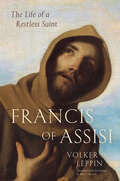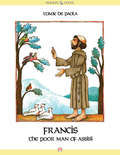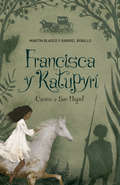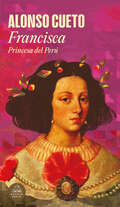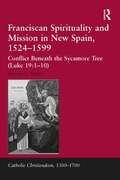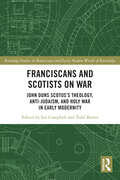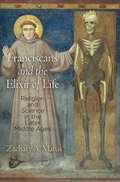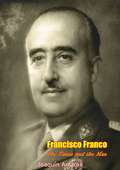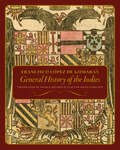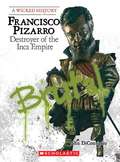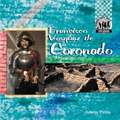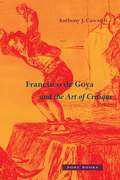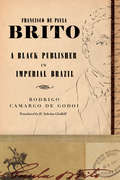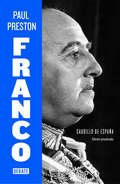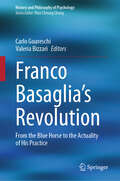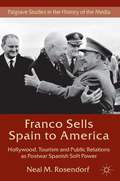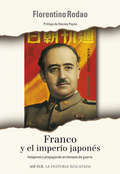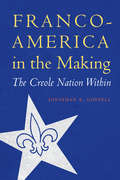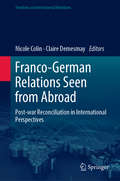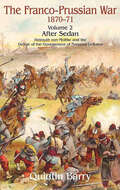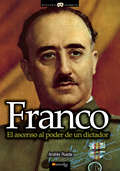- Table View
- List View
Francis of Assisi: The Life of a Restless Saint
by Volker LeppinAn award-winning historian reconstructs the life of Francis of Assisi, uncovering the man behind the myths One of the most famous figures in Christian history, Francis of Assisi (1181/82–1226) was revered as a miracle worker during his life and quickly canonized after his death. He has inspired generations of Christians and other spiritual seekers, from medieval ascetics to 1960s hippies and modern environmentalists. The &“poverello&” wrote poems praising the sun, moon, and stars, spoke to the birds, and—so the story goes—even tamed a wolf. But what do we know for sure about who he was, and what is simply legend? Drawing on centuries of scholarship, Volker Leppin pieces together fragments of Francis&’s life story to find a seeker who never reached his destination, a man whose extraordinary charisma drew others in yet who was uncomfortable in the spotlight. Amazingly, Francis stayed within the fold of the church while offering a new and radical vision of Christianity that proved wildly popular. Leppin&’s Francis of Assisi sets Francis&’s inner emotional and spiritual world against a broader historical background to show how the message of this inspiring and often vexing medieval saint continues to resonate in our contemporary world.
Francis, the Poor Man of Assisi
by Tomie De PaolaBeautifully drawn illustrations pair with great storytelling in this glimpse into the life of Francis of AssisiIn lively prose and folksy paintings, Tomie dePaola gives a glimpse into the life of Francis of Assisi. After witnessing his father disrespect a beggar, Francis comes to forsake his worldly possessions and travel from village to village helping the poor and sheltering animals. dePaola's recognizable artistic style and episodic telling of events in the life of Francis are accessible to young readers, and the humble tales of the lives of the saints are told with tenderness and reverence. This is a fixed-format ebook, which preserves the design and layout of the original print book.
Francisca y Katupyrí: Camino a San Miguel
by Gabriel Bobillo Martín BlascoUna novela de aventuras, viajes, intrigas y el largo camino hacia la independencia de la Argentina. <P><P> Francisca, una niña de 11 años, acompaña a su padre Efraín en una travesía de tres meses en galera de Buenos Aires a Tucumán. Ambos son esclavos y escoltan a Don Pedro Medrano, rumbo al Congreso que reunirá a los representantes de las Provincias Unidas del Río de La Plata y decidirá la independencia de nuestra Patria. Luego de enfrentar las inclemencias del terreno, el clima y la fauna local, la galera es descubierta por una partida de mercenarios contratados por los realistas para interferir con el Congreso. <P><P>Y tras una intensa persecución son interceptados bajo fuego. Cuando todo parece perdido, Medrano, Francisca y su padre son rescatados por una tropa informal de indios guaraníes y los mercenarios se ven forzados a huir. Por lo menos por un tiempo. Sin embargo, la tropa guaraní se encuentra camino a la Banda Oriental, para engrosar las filas de Artigas y no puede ofrecerse a escoltarlos durante el resto del viaje. Herido, y a cambio de la promesa de liberar a su hija de su esclavitud, Efraín accede a que Francisca se les anticipe a caballo para llevar a Tucumán una documentación vital para el Congreso. Los guaraníes, por su parte, le ofrecen como custodia a Katupyrí, el menor de sus hombres. <P><P>Un niño duro y precoz de 12 años, que asistirá a Francisca como su baqueano y protector. Juntos, los chicos emprenden una carrera de obstáculos que incluye más persecuciones y hasta algún enfrentamiento para lograr entregar los documentos antes de que sea demasiado tarde.
Francisca: Princesa del Perú
by Alonso Cueto"Mi misión esencial en el mundo ya no era reinar, sino recuperar todos mis pasados". Figura emblemática del naciente Virreinato peruano, en cuyo corazón se baten las sangres de dos imperios, Francisca Pizarro Huaylas Yupanqui, heredera exiliada del linaje de los incas e hija del conquistador Francisco Pizarro, se supo siempre una "princesa mimada, enriquecida, desterrada", así como una "viajera encarcelada, liberada y libre". Escindida entre el Perú y España, la íntima historia de Francisca, colmada de devoción, cálculo, pasión y nobleza, es también la de una época de connivencias políticas. En ese entramado de ambiciones dinásticas se configura el escenario de un mundo que se impone a la fuerza, y otro que se extingue bajo sus dominios, pero que pervive en la palabra de quienes invocan el pasado con más orgullo que nostalgia. Con el aliento poético y la finura narrativa que distinguen a sus novelas históricas, Alonso Cueto ha sabido dotar de luz y voz propias a un personaje memorable. Francisca. Princesa del Perú inscribe en el imaginario literario el destino histórico de una mujer que quiso vivir siempre a la altura de las cuatro palabras de su nombre.
Franciscan Spirituality and Mission in New Spain, 1524-1599: Conflict Beneath the Sycamore Tree (Luke 19:1-10) (Catholic Christendom, 1300-1700)
by Steven E. TurleyFranciscans in sixteenth-century New Spain were deeply ambivalent about their mission work. Fray Juan de Zumárraga, the first archbishop of Mexico, begged the king to find someone else to do his job so that he could go home. Fray Juan de Ribas, one of the original twelve 'apostles of Mexico' and a founding pillar of the church in New Spain, later fled with eleven other friars into the wilderness to escape the demands of building that church. Fray Jerónimo de Mendieta, having returned from an important preaching tour in New Spain, wrote to his superior that he did not want to enlist again, and that the only way he would return to the mission field was if God dragged him by the hair. This discontent was widespread, grew stronger with time, and carried important consequences for the friars' interactions with indigenous peoples, their Catholic co-laborers, and colonial society at large. This book examines that discontent and seeks to explain why the exhilaration of joining such a 'glorious' enterprise so often gave way to grinding discontent. The core argument is that, despite St. Francis's own longing to do mission work, his followers in New Spain found that effective evangelization in a frontier context was fundamentally incompatible with their core spirituality. Bringing together two streams of historiography that have rarely overlapped - spirituality and missions - this book marks a strong contribution to the history of spirituality in both Latin America and Europe, as well as to the growing fields of transatlantic and world history.
Franciscans and Scotists on War: John Duns Scotus’s Theology, Anti-Judaism, and Holy War in Early Modernity (Routledge Studies in Renaissance and Early Modern Worlds of Knowledge)
by Ian Campbell and Todd ResterFranciscan friars were everywhere in the early modern Catholic world, a world that stretched from the Americas, through Western and Central Europe, to the Middle East and Asia. This global brotherhood was as deeply entangled in the great religious wars that convulsed Europe during the sixteenth and seventeenth centuries as it was in the Spanish and Portuguese empires. While the political and imperial theories of Dominicans like Francisco de Vitoria and Bartolome de Las Casas, who took the theology of Thomas Aquinas as their starting point, are well-known, this has not been the case for Franciscan thinking until now.The Franciscans and their allies built a body of political writings around the theology of John Duns Scotus (1265/6–1308), and this book presents a wide selection of sixteenth- and seventeenth-century Scotist writings on politics, warfare, and empire in English for the first time. Beginning with Scotus’s own doctrine on the forced baptism of Jews, this collection translates John Mair (1467–1550) on European imperialism and holy war, Alfonso de Castro (1495–1558) on the Schmalkaldic War of the 1540s, Juan Focher (1497–1572) on the war against the Chichimeca Indians of Mexico, and John Punch on the British and Irish Civil Wars of the 1640s and 1650s.The availability of these primary sources for teaching and research will clarify the connection between religion, politics, and imperialism in the early modern world.
Franciscans and the Elixir of Life: Religion and Science in the Later Middle Ages (The Middle Ages Series)
by Zachary A. MatusOne of the major ambitions of medieval alchemists was to discover the elixir of life, a sovereign remedy capable not only of healing the body but of transforming it. Given the widespread belief that care for the body came at the cost of care for the soul, it might seem surprising that any Franciscan would pursue the elixir, but those who did were among its most outspoken and optimistic advocates. They believed they could distill a substance that would purify, transmute, and ennoble the human body as well as the soul. In an age when Christians across Europe were seeking material evidence for their faith and corporeal means of practicing their devotion, alchemy, and the elixir in particular, offered a way to bridge the terrestrial and the celestial.Framed as a history around science, Franciscans and the Elixir of Life focuses on alchemy as a material practice and investigates the Franciscan discourses and traditions that shaped the pursuit of the elixir, providing a rich examination of alchemy and religiosity. Zachary A. Matus makes new connections between alchemy, ritual life, apocalypticism, and the particular commitment of the Franciscan Order to the natural world, shedding new light on the question of why so many people claimed to have made, seen, or used alchemical compounds that could never have existed.
Francisco Franco: The Times and the Man
by Joaquín ArrarásFrancisco Franco: The Times and the Man, is the English translation of Dr. Joaquin Arrara´s’ biography of Francisco Franco Bahamonde, the Spanish general and politician who ruled over Spain as a military dictator from 1939, after the nationalist victory in the Spanish Civil War, until his death in 1975—a period commonly known as Francoist Spain in Spanish history.Born in 1892 in El Ferrol, Spain, Franco was a career soldier who rose through the ranks until the mid-1930s. When the social and economic structure of Spain began to crumble, he joined the growing right-leaning rebel movement. He soon led an uprising against the leftist Republican government and took control of Spain following the bloody Spanish Civil War (1936-39) when, with the help of Nazi Germany and Fascist Italy, his Nationalist forces overthrew the democratically elected Second Republic. Franco then presided over a brutal military dictatorship, persecuting political opponents, repressing the culture and language of Spain’s Basque and Catalan regions, and censuring the media. He died in Madrid in 1975, as Spain transitioned to a democracy.“It is with Franco, then, that [Arrarás] is concerned, with his character, his early upbringing, his entrance into the army, his thrilling adventures, his dramatic military career that made him through merit alone a captain at the age of twenty and Europe’s youngest general at thirty-two. We next find him, on his return home, commissioned to establish the Spanish West Point, immediately destroyed by the new government. Quickly after this there follow the world-stirring events that now are history.[…]“Fortunately the author’s work, in its transformation from Spanish into English, has lost none of its freshness and flavor. The velvet is still on the fruit. We have apparent here the same journalistic verve, the same vividness of narration, the same colorful descriptions and sharp-edged statement of facts…”
Francisco López de Gómara's General History of the Indies
by Clayton Miles Lehmann Angela HelmerThis work is the first English translation of the entire text of part one of sixteenth-century Spanish historian Francisco López de Gómara’s General History of the Indies. Including substantial critical annotations and providing access to various readings and passages added to or removed from the successive editions of the 1550s, this translation expands the archive of texts available to English speakers reconsidering the various aspects of the European invasion of America. General History of the Indies was the first universal history of the recent discoveries and conquests of the New World made available to the Old World audience. At publication it consisted of two parts: the first a general history of the European discovery, conquest, and settlement of the Americas, and the second a detailed description of Cortés’s conquest of Mexico. Part one—in the multiple Spanish editions and translations into Italian and French published at the time—was the most comprehensive, popular, and accessible account of the natural history and geography of the Americas, the ethnology of the peoples of the New World, and the history of the Spanish conquest, including the most recent developments in Peru. Despite its original and continued importance, however, it had never been translated into English. Gómara’s history communicates Europeans’ general understanding of the New World throughout the middle and later sixteenth century. A lively, comparatively brief description of Europe’s expansion into the Americas with significant importance to today’s understanding of the early modern worldview, Francisco López de Gómara’s General History of the Indies will be of great interest to students of and specialists in Latin American history, Latin American literature, anthropology, and cultural studies, as well as specialists in Spanish American intellectual history and colonial Latin America.
Francisco Pizarro: Destroyer of the Inca Empire
by John DiconsiglioBiography of Francisco Pizarro and his effects on the Inca Empire, for teens.
Francisco Vasquez de Coronado
by Kristin PetrieThis text traces the life of Francisco Vasquez de Coronado, who led a major expedition from Mexico through what is now the southwestern United States.
Francisco de Goya and the Art of Critique
by Anthony J. CascardiAn innovative study of Goya's unprecedented elaboration of the critical function of the work of artFrancisco de Goya and the Art of Critique probes the relationship between the enormous, extraordinary, and sometimes baffling body of Goya’s work and the interconnected issues of modernity, Enlightenment, and critique. Taking exception to conventional views that rely mainly on Goya’s darkest images to establish his relevance for modernity, Cascardi argues that the entirety of Goya’s work is engaged in a thoroughgoing critique of the modern social and historical worlds, of which it nonetheless remains an integral part. The book reckons with the apparent gulf assumed to divide the Disasters of War and the so-called Black Paintings from Goya’s scenes of bourgeois life or from the well-mannered portraits of aristocrats, military men, and intellectuals. It shows how these apparent contradictions offer us a gateway into Goya’s critical practice vis-à-vis a European modernity typically associated with the Enlightenment values dominant in France, England, and Germany. In demonstrating Goya’s commitment to the project of critique, Cascardi provides an alternative to established readings of Goya’s work, which generally acknowledge the explicit social criticism evident in works such as the Caprichos but which have little to say about those works that do not openly take up social or political themes. In Francisco de Goya and the Art of Critique, Cascardi shows how Goya was consistently engaged in a critical response to—and not just a representation of—the many different factors that are often invoked to explain his work, including history, politics, popular culture, religion, and the history of art itself.
Francisco de Paula Brito: A Black Publisher in Imperial Brazil
by Rodrigo Camargo GodoiFrancisco de Paula Brito is a biography of a merchant, printer, bookseller, and publisher who lived in Rio de Janeiro from his birth in 1809 until his death in 1861. That period was key to the history of Brazil, because it coincided with the relocation of the Portuguese Court from Lisbon to Rio de Janeiro (1808); the dawning of Brazilian Independence (1822) and the formation of the nation-state; the development of the press and of Brazilian literature; the expansion and elimination of the trans-Atlantic slave trade; and the growth of Rio de Janeiro&’s population and the coffee economy. Nevertheless, although it covers five generations of Paula Brito&’s family—men and women who left slavery in the eighteenth century—this book focuses on its protagonist&’s activities between the 1830s and 1850s. During that period, Francisco de Paula Brito became one of the central figures in the cultural and political scene in the Imperial capital, particularly through his work as a publisher. Paula Brito&’s success was due in part to his ability to forge solid alliances with the Empire&’s ruling elite—among them leading politicians responsible for the unification of the vast Brazilian territory and for the maintenance of slavery and the illegal trafficking of Africans. Consequently, through the books and newspapers he published, Francisco de Paula Brito became part of a much larger project.
Franco (edición actualizada): Caudillo de España
by Paul PrestonLa publicación de esta edición revisada y actualizada de la biografía de Franco de Paul Preston, a los cuarenta años de la muerte del dictador, es un acontecimiento, no en vano sigue siendo considerada unánimemente como la obra de referencia. Contra la visión de Franco como figura providencial, una biografía completísima, rigurosa y apasionante del hombre que rigió España durante tantos años, donde se muestra al militar ambicioso e implacable, al admirador de Hitler y Mussolini; al dirigente político cada vez más pagado de su propio papel, pero incapaz de comprender la complejidad de Estado y la economía modernas. Queda el hombre visceralmente conservador, tan cauto como ambicioso, hábil en el manejo de las personas y de los contrapesos del poder. Un libro imprescindible para quien quiera comprender la historia reciente de España, así como a uno de los personajes centrales de la misma. La crítica ha dicho...«Paul Preston ha escrito, y con gran diferencia, la mejor biografía del dictador Franco.»L.M. Anson «La biografía definitiva y apasionante del dictador español Francisco Franco.»Publishers Weekly «Preston nos presenta un retrato de Franco muy diferente al que generalmente conocemos.»Kirkus Review
Franco Basaglia's Revolution: From the Blue Horse to the Actuality of His Practice (History and Philosophy of Psychology)
by Carlo Guareschi Valeria BizzariThis book explores the importance of the work of Franco Basaglia, a pioneer in the democratic psychiatry movement. Using a multidisciplinary approach combining philosophy and psychology this volume seeks to illuminate the past and create a clearer picture of Basaglia's impact in conceptualizing modern psychiatric care. It reviews the contemporary status of care and offers new insights for a critical evaluation of care that takes the psychiatric revolution to a new level. Highlights Basaglia’s diagnostic and clinical practice Employs a multi-disciplinary approach Joins phenomenology and critical theory
Franco Modigliani and Keynesian Economics: Theory, Facts and Policy (Perspectives in Economic and Social History)
by Antonella RancanThis book follows the intellectual path of Franco Modigliani, Nobel Prize winner and one of the most influential Keynesian economists of the twentieth century, tracing his development and examining the impact of his research. The book begins with Modigliani’s early work as a young law student in 1930s Italy and traces his development through his emigration to the US, his introduction to Keynes’ General Theory at the New School, and his seminal 1944 article on Keynesian and classical economics. The book also examines Modigliani’s pioneering theory of savings: the life-cycle hypothesis (with Richard Brumberg), and the Modigliani–Miller theorem, a cornerstone of modern theory of finance. The book argues that although Modigliani is placed amongst the most prominent Keynesian economists, his connections with Keynesian theory are of secondary importance until the beginning of the 1960s when he joined MIT. This is the first book to place Modigliani’s thought in its proper historical context, showing how it related to wider economic concerns and examining the social and political implications of his work. It will be of interest to scholars in the history of economic thought, and especially post-war American Keynesian economics.
Franco Sells Spain to America
by Neal M. RosendorfA groundbreaking study of the Franco regime's utilization of Hollywood film production in Spain, American tourism, and sophisticated public relations programs - including the most popular national pavilion at the 1964-65 New York World's Fair - in a determined effort to remake the Spanish dictatorship's post-World War II reputation in the US.
Franco and the Spanish Civil War
by Filipe Ribeiro De MenesesFranco and the Spanish Civil War is a wide-ranging and insightful analysis of the origins, course, and consequences of the conflict and of Franco's role within it. It offers a broad view of the war through a survey of the social and cultural dimensions, as well as the military and political ones. In particular, it traces Franco's meteoric rise to power, his conduct in the war, and his long subsequent rule. This authoritative introduction illuminates the many different interpretations of the conflict by examining a variety of perspectives. Franco and the Spanish Civil War places the war in its national and global contexts, exploring both nationalist and republican points of view, and giving attention to foreign participation in the conflict.
Franco y el Imperio Japonés
by Florentino Rodao GarcíaInsólito estudio sobre la relaciones entre España y Japón durante la Segunda Guerra Mundial. El interés que la historiografía ha mostrado hacia las relaciones de la España franquista con la Alemania nazi y la Italia fascista ha provocado que se olvidaran las existentes con el régimen japonés, que también formaba parte del Eje. Y tales relaciones, a pesar de la lejanía y las dificultades de comunicación, tenían que ser relevantes en la estrategia de Japón que, ya enfrascado en una guerra de conquista en China, había abierto nuevos frentes de batalla en el sudeste asiático y el Pacífico en el marco de la Segunda Guerra Mundial. Las posibilidades de cooperación entre ambos regímenes tuvieran nuevas dimensiones con la expansión continental de los años 1940-41 y, posteriormente, con las actividades que asumió Madrid por cuenta de Tokio después de Pearl Harbor: el espionaje y la protección de las numerosas colonias de emigrantes japoneses en elcontinente americano, las más importantes que realizó un país neutral. El distanciamiento español de Japón cuando terminó el ciclo de victorias militares del imperio -Franco incluso llegó a especular con una declaración de guerra en marzo de 1945, que rechazaron los aliados- sirvió de ensayo al régimen para la previsible ruptura con Alemania e Italia y el acercamiento a los Aliados. La característica fundamental de los contactos es que, a diferencia de los que mantenía el régimen con Alemania e Italia, nunca se desarrollaron bajo el signo de la afinidad cultural e ideológica, sino sólo como alianza utilitaria. Por eso para Franco -que creía que la derrota de Japón era consecuencia de la incapacidad de los orientales para acceder a la civilización- la ruptura no fue difícil.
Franco-America in the Making: The Creole Nation Within (France Overseas: Studies in Empire and Decolonization)
by Jonathan K. GosnellEvery June the city of Lowell, Massachusetts, celebrates Franco-American Day, raising the Franco-American flag and hosting events designed to commemorate French culture in the Americas. Though there are twenty million French speakers and people of French or francophone descent in North America, making them the fifth-largest ethnic group in the United States, their cultural legacy has remained nearly invisible. Events like Franco-American Day, however, attest to French ethnic permanence on the American topography. In Franco-America in the Making, Jonathan K. Gosnell examines the manifestation and persistence of hybrid Franco-American literary, musical, culinary, and media cultures in North America, especially New England and southern Louisiana. To shed light on the French cultural legacy in North America long after the formal end of the French empire in the mid-eighteenth century, Gosnell seeks out hidden French or “Franco” identities and sites of memory in the United States and Canada that quietly proclaim an intercontinental French presence, examining institutions of higher learning, literature, folklore, newspapers, women’s organizations, and churches. This study situates Franco-American cultures within the new and evolving field of postcolonial Francophone studies by exploring the story of the peoples and ideas contributing to the evolution and articulation of a Franco-American cultural identity in the New World. Gosnell asks what it means to be French, not simply in America but of America.
Franco-German Relations Seen from Abroad: Post-war Reconciliation in International Perspectives (Frontiers in International Relations)
by Nicole Colin Claire DemesmayThis book examines external perceptions of the Franco-German relationship, both from a historical perspective and as a driving force for regional integration. By providing various country and regional studies, it analyses the various types of perception and self-perception in several regions around the globe. Here, Franco-German cooperation serves as a mirror in which third-party countries view their own situation, today and in the future. The contributions address the questions of if and how the Franco-German reconciliation and cooperation is perceived as a role model for other regions, especially for the reconciliation of other inter-state and international conflicts. A concluding chapter highlights the divergences and convergences between the respective conflicts, and proposes recommendations for actors involved in diplomacy and international relations.The book is intended to provide scientific support for the implementation of the Franco-German Aachen Treaty of January 2019. It will appeal to scholars in political science and cultural studies, and to anyone interested in learning more about the Franco-German relationship and on external perspectives on it.
Franco-Israeli Relations, 1958-1967 (Routledge Studies in Modern European History)
by Gadi HeimannSince the Sinai campaign, France had been Israel's ally, providing advanced weapons and granting political support and economic aid. When Charles de Gaulle returned to lead France in 1958 during the Algerian War, Israeli leadership faced a challenge to maintain the friendship in light of the President's insistence on re-establishing French influence in the Arab world. This book discusses their efforts and examines de Gaulle's uncompromising pursuit of French grandeur and the ramifications of this for the State of Israel.
Franco-Prussian War 1870–1871, Volume 1: The Campaign of Sedan: Helmuth Von Moltke and the Overthrow of the Second Empire (Franco-prussian War 1870-1871 Volume 1: The Campaign Of Sedan Ser. #1)
by Quintin BarryThe first volume of this comprehensive study of the Franco-Prussian War presents a detailed account of Germany Confederation&’s decisive victory over France. In the first part of this two-volume military history, Quintin Barry examines the war against the French Imperial Army waged by the armies of the German Confederation, directed by that supreme military mind, Helmuth von Moltke. Barry places Moltke and his strategic planning in the context of the European balance of power following the ending of the Austria Prussian War in 1866. He then explores the initial mobilization and deployment of the armies in 1870. All the battles of this opening round of the war are described in detail, including Weissenburg, Worth, Spicheren, Borny-Colombey, Mars la Tour, Gravelotte, Beaumont and, of course, Sedan. The book ends as the Second Empire of Napoleon III lies defeated, crushed by the German armies. Barry has made full use of an extensive number of German and French language sources. His detailed text is accompanied by a number of black and white illustrations and newly drawn battle maps. Orders of battle are also provided.
Franco-Prussian War 1870–1871, Volume 2: After Sedan: Helmuth Von Moltke and the Defeat of the Government of National Defence (Franco-prussian War 1870-1871 Volume 2: After Sedan Ser. #2)
by Quintin BarryThe second volume of this comprehensive military history examines the fall of the Second French Empire and the founding of a unified Germany.Helmuth von Moltke&’s victory over France in the Battle of Sedan resulted in the capture of Napoleon III. But the war against the Government of National Defense presented quite different problems to von Moltke and his staff.Although the Siege of Paris loomed large during the second phase of the war, historian Quintin Barry fully explores events in other parts of France, including the siege of Strasbourg, the activities of the Francs Tireurs, the investment of Metz, and the battle against the French armies of the Loire, the North, and the East. As with the first volume of this study, Barry has made full use of an extensive number of German and French language sources. His detailed text is accompanied by a number of black and white illustrations and newly drawn battle maps. Orders of battle are also provided.
Franco. El ascenso al poder de un dictador (Historia Incógnita)
by Andrés RuedaUna novedosa biografía de Francisco Franco basada en una rigurosa investigación histórica apoyada en una espectacular cantidad de material gráfico. Conozca en detalle todos los episodios clave de su carrera militar, del alzamiento y de la Guerra Civil, que le condujeron a convertirse en el Caudillo. Descubra también la faceta más humana de un dictador atormentado, inseguro y oportunista, que gracias a su astucia y personalidad llegó a convertirse en la figura más determinante de la historia de España durante el siglo XX Esta obra, finalista del premio Espejo de España, es una novedosa aproximación a la figura de Francisco Franco desde dentro. El psiquiatra Andrés Rueda se adentra en la biografía del dictador para rebuscar los episodios clave de su vida, las consecuencias que tuvieron en la forma de actuar y pensar de Franco, y cómo repercutieron esos traumas en la historia de España. Una investigación histórica y psicológica apoyada con una espectacular cantidad de material gráfico, que incluyen fotografías desconocidas, donde Andrés Rueda analiza los hechos, sus discursos, sus conversaciones, sus reacciones para trazar un perfil de este dictador con la máxima precisión y rigor y huyendo de los revisionismos interesados. Gracias a esta obra sin parangón, Franco, por primera vez, aparece en su faceta más humana, alejada de las brillantes distorsiones propagandísticas que rodearon su figura, en un intento, no de justificación, si no de explicación de por qué Franco se convirtió en la figura más determinante en la historia de España durante el siglo XX. A través de las páginas de esta obra, el lector descubrirá a un Franco acomplejado y atormentado, lleno de razones y sinrazones, inseguro y oportunista, un hombre mediocre y vulgar, que llegó a dirigir el destino de todo un país durante más de cuarenta años. Argumentos de venta - Se trata de la primera biografía de Franco que combina la historia rigurosa de su carrera y hechos militares, el análisis brillante de su compleja y atormentada personalidad y su ambición de dictador. - El título está repleto de citas bibliográficas, información inédita de diversas fuentes, prensa de la época... que documentan los hechos narrados dotándolos de rigor histórico. - Rueda presenta documentación y tésis inéditas sobre Franco, como la dudosa paternidad de su hija Carmen, la clave criptográfica usada en la comunicación del alzamiento o la foto de Franco sin bigote. - Franco permite entender de modo claro las razones y hechos que llevaron a un joven e inexperto general a autoproclamarse caudillo de España
